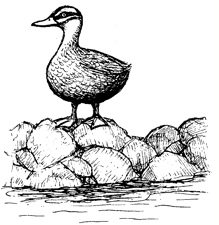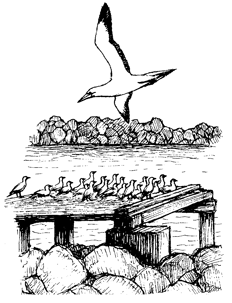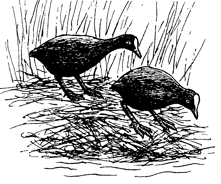A Duck is Not a Humanby Eddy Burger |
|
|
part 1 of 4 |
A lot can be said for Australian wildlife. A lot can be said particularly about birds. A duck, for instance, is not just a duck. It might be a Pacific Black Duck, which happen to be very common around Melbourne, Australia, or it might be a Maned Duck, which are extremely rare around Melbourne, Australia. Nevertheless, a duck is not a human.
 A Pacific Black Duck |
A duck is more closely related to a gannet than a human, even though Pacific Black Ducks live in closer proximity to humans than to gannets. Australian Gannets, for instance, are birds and they have webbed feet, like ducks, but they inhabit saltwater environs of Australia, spending most of their time out at sea. They roost on coastal lands only to roost. Pacific Black Ducks inhabit freshwater environs and can often be seen frequenting the same pond or lake that humans frequent, though it should be clarified that they do not, generally speaking, play together since ducks are, generally speaking, shy of humans, yet they are frequently beheld consorting only metres from each other. So not only is a human not a duck but it is not not a duck just because it does not have webbed feet. And neither is a human a gannet just because it is not not not a duck.
 Australian gannets |
A human is not a gannet. Humans and gannets do sometimes share the same environment, such as jetties or coastal rocks, though the kindredship between humans and gannets is not quite so apparent as between humans and ducks. However, many ducks and gannets in the world might live their whole lives without seeing a human. A human might live its whole life without seeing a gannet, but much less frequent would be instances of a human who has lived its whole life without seeing a duck.
Of all ducks, the Bald Duck most closely resembles a human. It is, of course, not bald but, like a human, the majority of its body has only a sparse covering, which is appropriate to the tropical climes that it inhabits. It is actually comparable only to the most hairy of men or women, and it can still fly since its wings are well feathered.
The Bald Duck has a much denser covering of feathers on the top of its head, so it is not bald in the same manner a man might be said to be bald. Its very feathered cranium contributes to its uncanny resemblance to a human. The Bald Duck is a lesser known relative of the Tufted Duck and is also of the same phylum as the Bird Of Paradise Duck, whose cranium feathers hang down to below its waist.
A lot can be said about ducks. They are well known for their quack, their waddle, their bill and webbed feet. Their bodies are built for floating. No other bird spends as much time floating (except swans, which are a very ugly type of duck).
Humans use ducks for food, farming and game shooting. Granted, most creatures are the food of another. When I was pecked by a duck, I knew it was fate. But ducks are also cherished for the ornamental and atmospheric contribution they provide to parks, gardens and many a serene landscape. Their influence is apparent through various terms and phrases in the English language, such as “Ducky,” “ducks and drakes,” “like water off a duck's back,” “take to something like a duck out of water,” “such and such is a sitting duck,” and so on.
They are also a focus for comedy, owing perhaps to the way they walk, sound and/or behave, but also to the fact that they are so prominent and common in certain parts of the world. They have featured, for instance, in some of Monty Python's comedy sketches, as well as in cartoons. Not many cartoon characters have endured for decades, but not only is a duck among their number, but two ducks: Daffy and Donald.
Children, generally speaking, love ducks. The child of a friend of mine loves ducks. She painted a picture of a big air balloon that bore the message “Going to Duck Land.” Ducks have featured in many fairytales, such as “The Ugly Duckling,” “The Three Little Ducks,” “The Duck Girl,” “The Duck, the Gannet and the Coot,” and so on.
 Eurasian Coots |
Yet coots do not have webbed feet. Just because a coot is not a duck (because it does not have webbed feet) does not mean that a human is a coot. A human is not a coot, although the word “coot” is sometimes used as a derogatory term for a human who is foolish and/or disliked, as illustrated in the following exclamations: “the silly coot!” or “he took my parking spot, the rotten coot!.”
It is often the case that the person labelled a “coot” is of an elderly age, i.e.: “the old coot.” Yet the label “coot” is never severely derogatory and can even carry overtones of endearment, i.e.: “you silly old coot.” The same, however, cannot be said of a bandicoot. A human is a lot like a bandicoot. They are both mammals, they both have hair on the top of their heads and neither has webbed feet.
[Author’s note] All illustrations are derived from illustrations in Melbourne Nat'rally, written by Doug Western, illustrated by Edward Burger (Melbourne, 1987).
To be continued...
Copyright © 2008 by Ed Burger
